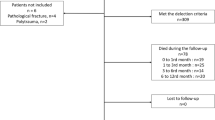Key Summary Points
To identify the determinants of in-hospital mortality post-hip fracture in Ireland 2013–2017.
AbstractSection FindingsOlder males with poor pre-fracture mobility who were not mobilised on the day of/after surgery had the highest risk of in-hospital mortality.
AbstractSection MessageEarly mobilisation on the day of/after surgery should be added as a new formal hip fracture standard of care in keeping with best international practice.
Abstract
Purpose
Hip fractures are associated with considerable morbidity, excess mortality, and significant healthcare expenditure. There are approximately 3700 hip fractures in Ireland per annum and this figure is set to rise in the next decade in parallel with the ageing population. Approximately 5% of patients who sustain a hip fracture will die in hospital, with less than half of survivors regaining their pre-operative level of function. The authors aimed to identify the determinants of in-hospital mortality post-hip fracture in Ireland 2013–2017.
Methods
A secondary analysis of 15,603 patients in the Irish Hip Fracture Database (IHFD) was conducted. Both descriptive and analytical statistics were produced. Univariate and multivariate logistic regression was carried out.
Results
31% (n = 4796) of patients were male and 69% (n = 10,807) were female. Mean age for males was 75 years (SD 13.5) and 79 years for females (SD 10.5). Median in-hospital mortality was 4.7% (n = 711) (range 2.7–6.2). Univariate logistic regression revealed 11 statistically significant predictors of in-hospital mortality; however, only four remained statistically significant on multivariate analysis [not mobilised day of/after surgery (OR 1.46, 95% CI 1.25–1.70, p < 0.001), independent mobility pre-fracture (OR 0.84, 95% CI 0.79–0.89, p < 0.001), female gender (OR 0.56, 95% CI 0.41–0.76, p < 0.001), and older age (OR 1.05, 95% CI 1.03–1.06, p < 0.01)].
Conclusion
Older males with poor pre-fracture mobility who were not mobilised on the day of/after surgery had the highest risk of in-hospital mortality. This research supports the adoption of early mobilisation (day of/after surgery) as a new formal hip fracture standard in keeping with best international practice.

Similar content being viewed by others
References
Holvik K, Ranhoff AH, Martinsen MI, Solheim LF (2010) Predictors of mortality in older hip fracture in-patients admitted to an orthogeriatric unit in Oslo. Norway J Aging Health 22(8):1114–1131. https://doi.org/10.1177/0898264310378040
Dodds MK, Codd MB, Looney A, Mulhall KJ (2009) Incidence of hip fracture in the Republic of Ireland and future projections: a population-based study. Osteoporos Int 20(12):2105–2110. https://doi.org/10.1007/s00198-009-0922-1
Ojeda-Thies C, Sáez-López P, Currie CT, Tarazona-Santalbina FJ, Alarcón T, Muñoz-Pascual A, Pareja T, Gómez-Campelo P, Montero-Fernández N, Mora-Fernández J et al (2019) Spanish National Hip Fracture Registry (RNFC): analysis of its first annual report and international comparison with other established registries. Osteoporos Int 30(6):1243–1254
Wagner P, Fuentes P, Diaz A, Martinez F, Amenabar P, Schweitzer D, Botello E, Gac H (2012) Comparison of complications and length of hospital stay between Orthopedic and Orthogeriatric treatment in elderly patients with a hip fracture. Geriatr Orthop Surg Rehabil 3(2):55–58. https://doi.org/10.1177/2151458512450708
National Office of Clinical Audit (2019) Irish Hip Fracture Database National Report 2018. National Office of Clinical Audit, Dublin
Kristensen M, Foss N, Kehlet H (2010) The new mobility score as a predictor of early independency in basic mobility after hip fracture surgery. Y Orthopaedic Proc 92-B(SUPP_II):304–304. https://doi.org/10.3109/17453674.2010.487240
Volpato S, Guralnik JM (2015) Hip fractures: comprehensive geriatric care and recovery. Lancet 385:1594–1595. https://doi.org/10.1016/S0140-6736(14)61592-0
Kelly MA, McGowan B, McKenna MJ, Bennett K, Carey JJ, Whelan B, Silke C (2018) Emerging trends in hospitalisation for fragility fractures in Ireland. Irish J Med Sci. https://doi.org/10.1007/s11845-018-1743-z
Kamel HK, Iqbal MA, Mogallapu R et al (2003) Time to ambulation after hip fracture surgery: relation to hospitalization outcomes. J Gerontol A Biol Sci Med Sci 58(11):1042–1045. https://doi.org/10.1093/gerona/58.11.m1042
Tarazona-Santabalbina FJ, Belenguer-Varea Á, Rovira E, Cuesta-Peredó D (2016) Orthogeriatric care: improving patient outcomes. Clin Interv Aging 11:843–856. https://doi.org/10.2147/CIA.S72436
Royal College of Physicians (2018) The physiotherapy hip fracture sprint audit. London. https://www.fffap.org.uk/FFFAP/landing.nsf/phfsa.html. Accessed 15 Feb 2020
Chartered Society of Physiotherapy. 2018. Hip fracture rehabilitation in physiotherapy practice: from hospital to home. Setting standards for high quality rehabilitation after hip fracture to help transform lives and maximise independence. Available at https://www.csp.org.uk/publications/hip-fracturerehabilitation-physiotherapy-practice
National Institute for Heallth and Care Excellence (2011) The management of hip fracture in adults (clinical guideline CG124). Available at https://www.nice.org.uk/guidance/cg124
Dubljanin-Raspopović E, Marković-Denić L, Marinković J, Nedeljković U, Bumbaširević M (2013) Does early functional outcome predict 1-year mortality in elderly patients with hip fracture? Clin Orthop Relat Res 471(8):2703–2710
Smith T, Pelpola K, Ball M, Ong A, Myint PK (2014) Pre-operative indicators for mortality following hip fracture surgery: a systematic review and meta-analysis. Age Ageing 43:464–471. https://doi.org/10.1093/ageing/afu065
Åhman R, Siverhall PF, Snygg J et al (2018) Determinants of mortality after hip fracture surgery in Sweden: a registry-based retrospective cohort study. Sci Rep 8(1):15695. https://doi.org/10.1038/s41598-018-33940-8
Holt G, Smith R, Duncan K, Finlayson DF, Gregori A (2008) Early mortality after surgical fixation of hip fractures in the elderly. An analysis of data from the Scottish Hip Fracture Audit. J Bone Joint Surg Br 90(10):1357–1363. https://doi.org/10.1302/0301-620X.90B10.21328
Sheehan KJ, Sobolev B, Guy P (2017) Mortality by timing of hip fracture surgery: factors and relationships at play. The Orthopaedic Forum. J Bone Joint Surg Am 99:e106(1-9). https://doi.org/10.2106/JBJS.17.00069
Funding
Funding was not received for this research.
Author information
Authors and Affiliations
Corresponding author
Ethics declarations
Conflict of interest
There are no conflicts of interest.
Ethical approval
Research ethics approval was obtained from the St James Hospital/ Tallaght University Hospital Research Ethics Committee, in accordance with the European Communities (Clinical Trials on Medicinal Products for Human Use) Regulations 2004 & ICH GCP Guidelines.
Informed consent
For this type of research, informed consent was not required.
Additional information
Publisher's Note
Springer Nature remains neutral with regard to jurisdictional claims in published maps and institutional affiliations.
Rights and permissions
About this article
Cite this article
Ferris, H., Brent, L. & Coughlan, T. Early mobilisation reduces the risk of in-hospital mortality following hip fracture. Eur Geriatr Med 11, 527–533 (2020). https://doi.org/10.1007/s41999-020-00317-y
Received:
Accepted:
Published:
Issue Date:
DOI: https://doi.org/10.1007/s41999-020-00317-y




